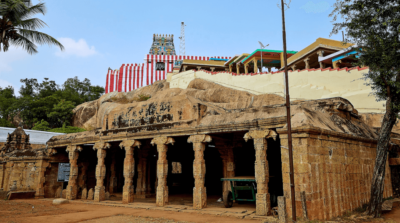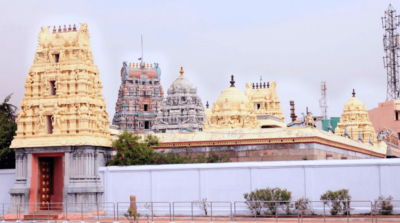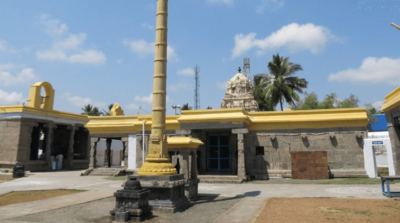Vadapalani Murugan Temple
Vadapalani Murugan Temple is one of the most prominent temples dedicated to Lord Murugan in Chennai, Tamil Nadu. Located in the Vadapalani area, the temple has become a major spiritual and cultural hub in the city. It is particularly famous for its beautiful architecture, religious significance, and the large number of devotees who visit regularly. As it’s in the city, couples who are getting married in the city would highly prefer this temple.
The temple was originally a small thatched hut built in the late 19th century by a devotee named Annaswami Nayakar, who was inspired by his deep devotion to Lord Murugan. Over time, it has grown into the magnificent structure it is today. The main deity, Lord Murugan, is depicted in a standing posture, and devotees believe that prayers offered here bring blessings in marriage, health, and success.
The temple also houses shrines for other deities, including Lord Shiva, Goddess Parvati, Lord Ganesha, and Lord Hanuman. Festivals like Thaipusam and Skanda Shasti are celebrated with great fervor, attracting devotees from all over India.
Vadapalani Murugan Temple is also known for its ornate Rajagopuram (main tower), which is adorned with intricate carvings depicting stories from Hindu mythology. The temple’s peaceful ambiance and spiritual energy make it a significant place of worship in Chennai.
Vadapalani Murugan Temple History
The Vadapalani temple was built in the late 19th century. It all began with Annasamy Naicker, a staunch devotee who with faith in the lord`s powers built a small thatched hut, placed a painted picture of Lord Murugan and began worshipping it religiously everyday. The story goes that once, Annasamy Naicker had chronic stomach ache that he couldn`t find cure to. He travelled wide and far visiting the sacred temples of Lord Muruga despite very limited to no transport facilities from Thiruthani, Thiruporur braving the rains, the cyclones and thieves on the roads.
One day a Sadhu appeared in Annasamy Naicker`s dreams and said when Murugan is right in your house why do you go in search of him all over? He started with a start, returned home and shared the story with his family and began worshipping the lord with fervent sincerity. With that, his daily Pooja routine continued twice every day in his very home. One day, on the word of a Palani Sadhu he met, Annasamy Naicker offered his tongue at the Thiruthani temple. That put an end to his ailments.
One day when he pursued his dream trip to the Southern Pazhaniyathra, as he returned after his Darshan of the Dandayuthapani, while descending the steps, a beautiful picture of lord Murugan grabbed his eyes. He was mesmerized by it. He considered it a priceless possession and brought it home to Chennai. He placed it in his home and put a thatched roof over it. He asked his family to shift elsewhere and considered it the very sacred aboard, the Palani. he started solving the problems of others with his Arul Vaakku during pooja. He is also known as Pavadam since he offered his tongue to Lord Muruga and took the Pavadam.
As time went by, he realized that Rathinasamy Chettiyar who was beside him, assisting in the proceedings at all times would be the best successor to take on the sacred deed. When asked at an unexpected and sudden moment Rathinasamy Chettiyar said with all humbleness and hesitation that since he is a family man he might not be able to take on as a successor but will continue to assist and be of help. In response, Annama Naiykar expressed his wish to build a temple at this spot. Rathinasamy Chettiyar accepted this task at once. He said if you give me your consent I shall begin the deed at once and would also arrange to make a beautiful idol as the one in Palani. Annamasami responded by asking why would one have to wait for consent when it comes to matters of good and gave Thiruneer to Rathinasay as a signal to begin the sacred work at once.
Chettiyar began the work the very next day. He made arrangements for the Palaniandavar`s sacred idol while Annamasami stood by all the works that followed towards the building of the Vadapalani temple. The construction went on in full swing. The Karuvarai was constructed using bricks and cement near the then Kuri Medai or the place where Annamasami used to solve the problems of others while in his trance. This is approximately said to have been in A.D 1865. At this juncture, one day, in the month of Avani, Ammavasai Thithi, Maga Nakshatram Annasami Thambiran attained spiritual abode.
One day, Annasami Thambiran appeared in Rathinasamy Chettiyar’s dream and requested him to dress like himself. Abiding by this, Rathinasamy did the same on an Templeikiruthikai day. From the next Kiruthikai onwards, Rathinasamy Chettiar was blessed with divine powers and started to solve the problems of others just as Annasami in a state of frenzied trance. In a few days, the temple construction was successfully completed as per Annasamis desire. Palaniandavars statue was placed and the Kumbabishekam took place in all this grandeur. The offerings of the devotees whose problems Rathinasamy solved were used for the temple proceedings and Poojas. After Kumbabishekam, Rathinasamy Chettiyar requested everyone to call the Kodambakkam Kurimedai the Vadapalani Lords temple. The temple’s popularity rose in Chennai. In 1886, Margazhi month, Sashta day, Sathya Nakshatra, Sri Rathisasamy Thamiran attained spiritual abode.
He was followed by Bagyalingam, an ardent follower of Lord Muruga, who followed Rathinasamy Thambiran, as his disciple and continued his work including Arul Vakku and poojas. Bagyalinga Thambiran continued developing the temple’s infrastructure. He is the man behind building the temple Karpa Kraha and the Thiruchutrum. It is his undeterred dedication that rose the popularity of the shrine bringing devotees in huge numbers.
Bagyalinga Thambiran attained spiritual abode in 1931, Purattasi Thingal, Dhasami Thithi, Poosa Nakshatra.
It is strongly believed that those who are unable to lead a pilgrimage to the Palani can very well visit the Vadapalni temple which shall provide all the grace and blessings of Palaniadavan to those who willfully and devotedly ask. This is a widely accepted truth that is felt and experienced by all devotees. Devotees, and senior citizens who are unable to visit Palani can visit the Vadapalani temple here in Chennai and give their offerings that they had prayed for the Palani Murugan. Plani Andavan shall shower his grace and blessings just as equally as he shall in the Southern Palani.
The shrine grew in fame due to its unique powers that helped hundreds of devotees. Siddars, Devotees, and Pioneers began visiting the temple in large numbers. Devotees who were unable to complete their prayers and offerings at Palani did so in Vadapalni temple having the lord in their minds. Devotees can also pray to the Vadapalani Murugan with Palaniandavan at heart. Lord Murugan shall bless them with the same grace.
The Samadis of all three Sitthars who worked towards building the sacred temple is situated in Nerkundram. The Siddarkal Alayamn is constructed to enable devotees to visit the Samadhis of all three Siddars at the same time. There are special Poojas conducted every Pournami. The Guru Pooja is also a speciality here.
Sacred temples gain their sanctity from their temple gods, the location and Theerthas. The Vadapalni temple has gained popularity due to Lord Shri Murugan. This sacred temple is known for the incomparable grace of Lord Shri Vadapalani Murugan. So many devotees swear by this sacred temple’s power and grace in solving problems especially related to education, delayed marriage, childbirth, and health and so on. Devotees worship lord Muruga and Lord Angaaran (Sevvai or the Mars god) to solve their issues by offering special prayers, Abishekams and Archanai.
It is proven that the Vadapalani Lord Murugan resolves the problems of his devotees and brings peace to their lives with his grace and blessings when worshipped. A lot of devotees who are unable to visit the Palani visit the Vadapalani temple giving their prayers and offerings. The Vapalani Murugan known as the Kalyug Varadhan blesses them The speciality of this temple is second to none. Mulavar is seen with his footwear which is a symbol that destroys arrogance. Lord Murugan’s left foot is seen to be a step ahead. It is believed that it is because the god is rushing forward to resolve issues of his devotees.
The holy tree or the Thala Vritcham of this temple is the fig tree. Devotees tie a small swing in the fig tree as their prayer for a child. Since prayers were answered without any hassle, the temple rose to fame. Devotees, as offerings give silver, gold etc in the Hundi. They also pierce spears in their tongue, offer sarees, tonsure their heads, pierce ears, take Paalkavadi, Pushpakavadi and so on.
Temple Amenities
Marriage hall
-
Temple-managed marriage permission available.
-
Can accommodate up to 3 marriages per day.
- Booking fee: ₹2,000 (marriage permission).
-
No online booking – apply directly at the temple office.
-
Decorations & catering not allowed inside the temple.
Tonsure Facility
-
Official tonsure area located behind the temple office.
-
Token fee: ₹100 per person, payable at the dedicated counter.
-
Operates daily: 5:00 AM–9:00 PM, with a break during afternoon hours.
Vehicle Parking
-
Two-wheeler parking available near the temple – ₹5 to ₹10.
-
Car parking is limited roadside – ₹20 to ₹50.
-
No dedicated temple parking lot.
Information Centre
-
Official temple office (Devasthanam) serves as the information center—for inquiries on poojas, darshan timings, ceremonies, and booking services.
-
Volunteers and staff, located near the entrance and inside the main hall.
-
Contact the temple office (Devasthanam) for detailed queries, including marriage bookings, pooja requests, and special services:
-
Phone: 044‑24836903, 044‑24802330.
-
Vadapalani Murugan Temple pooja
| Pooja Name | Pooja Timings (IST) |
|---|---|
| Palliyarai Pooja (Normal Decoration) | 05:30 AM – 06:00 AM |
| Kalasandhi Pooja (Normal Decoration) | 06:30 AM – 06:45 AM |
| Uchikkala Pooja (Santhana Kappu) | 12:00 PM – 12:30 PM |
| Sayaraksha Pooja (Evening, Santhana Kappu) | 05:00 PM – 06:45 PM |
| Ardhajama Pooja (No Decoration) | 09:00 PM |
Vadapalani Murugan Temple Archanai & Other Fees
| Fees Description | Fees (INR) |
|---|---|
| MILK ABISHEGAM | 700.00 |
| SANTHANAKAPPU | 3700.00 |
| SANGABISHEGAM | 6500.00 |
| THIRUKALYANAM | 8500.00 |
Vadapalani Murugan Temple 2025 Festivals
| Festival | Date (2025) | Highlights |
|---|---|---|
| Thaipusam | February 11, 2025 | Major Murugan festival with kavadi processions, milk abhishekam, body piercings |
| Panguni Uthiram | March/April (exact full moon date) | Celebrates Murugan’s divine marriage with special poojas and processions |
| Vaikasi Visakam | May 31–June 10; Main day June 9, 2025 | 11-day Brahmotsavam: flag hoisting, chariot procession, Kalasabhishekam, Thirukalyana Urchavam, Panchamurthi, Therottam |
| Skanda Sashti | October–November 2025 | Six-day festival culminating in the dramatic Soorasamharam reenactment |
| Karthigai Deepam | November–December 2025 | Temple illuminated with thousands of oil lamps in celebration of light triumphing over darkness |
| Monthly Pujas | Every Krithigai & month-end Sashti | Monthly observances with special abhishekams and devotional rituals |






